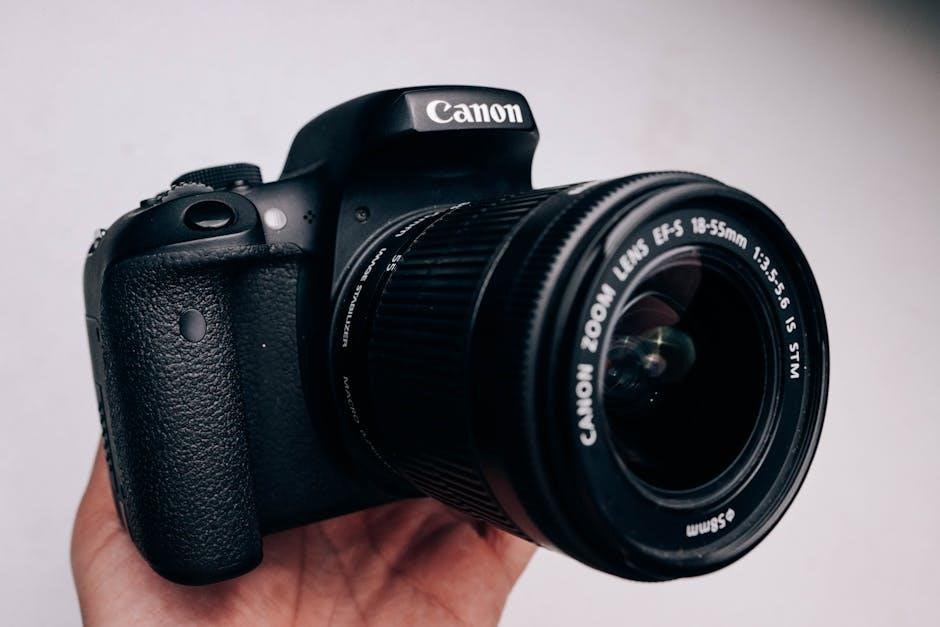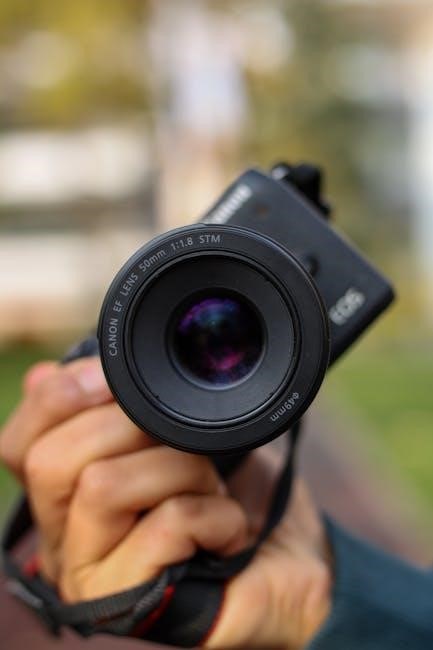The Canon Digital Rebel XT manual is a comprehensive guide to understanding and mastering the EOS 350D camera‚ covering its features‚ settings‚ and troubleshooting for photographers of all levels․
Overview of the Canon Digital Rebel XT
The Canon Digital Rebel XT‚ also known as the EOS 350D‚ is an 8-megapixel entry-level DSLR released in 2005․ It is a compact‚ lightweight camera designed for both novice and enthusiast photographers․ The XT features an APS-C CMOS sensor‚ a 2․4-inch LCD screen‚ and supports RAW and JPEG file formats; Known for its reliability and user-friendly interface‚ it offers a range of shooting modes‚ including automatic and manual controls․ This camera is celebrated for its portability and accessibility‚ making it a popular choice for those transitioning from film to digital photography․

Key Features of the Canon EOS 350D
The Canon EOS 350D boasts an 8-megapixel APS-C CMOS sensor‚ delivering crisp‚ high-resolution images․ It features a 2․4-inch LCD screen for previewing shots and reviewing images․ The camera supports ISO sensitivity from 100 to 1600‚ enabling versatile low-light shooting․ With a continuous shooting speed of 3 frames per second‚ it’s ideal for capturing action․ The EOS 350D also includes a built-in flash‚ E-TTL II metering‚ and compatibility with EF-S and EF lenses․ Its compact design and intuitive controls make it accessible for photographers of all skill levels‚ while offering advanced features for creative control․ This model is a versatile tool for both casual and professional use․

Understanding the Camera’s Design
The Canon Digital Rebel XT features a sleek‚ ergonomic design that balances functionality and portability․ Its intuitive layout provides easy access to controls‚ enhancing usability for photographers of all levels․
Ergonomics and Build Quality
The Canon Digital Rebel XT boasts a compact and lightweight design‚ weighing just 17․1 ounces‚ making it easy to carry for extended periods․ Its contoured grip ensures a secure hold‚ reducing fatigue during long shooting sessions․ Built with a durable polycarbonate body‚ the camera offers a balance of portability and sturdiness․ The ergonomic layout places essential controls within easy reach‚ promoting intuitive operation․ This design emphasizes comfort and practicality‚ catering to both amateur and advanced photographers seeking a reliable tool for capturing high-quality images in various settings․
Button Layout and Navigation
The Canon Digital Rebel XT features an intuitive button layout designed for easy navigation․ The top panel includes a mode dial for quick access to shooting modes‚ while the rear panel houses buttons for menu‚ playback‚ and delete functions․ A multi-controller joystick simplifies menu navigation and autofocus point selection․ Dedicated buttons for ISO‚ white balance‚ and drive mode reduce the need for deep menu diving․ The LCD screen provides clear access to settings and image review․ This logical arrangement allows photographers to adjust settings swiftly‚ enhancing the overall shooting experience with minimal distraction․
The Mode Dial and Shooting Modes
The Canon Digital Rebel XT’s mode dial offers a variety of shooting modes to suit different photography needs․ The dial includes Auto mode for point-and-shoot simplicity‚ Program AE (P) for automatic settings with user adjustments‚ and Manual (M) for full creative control․ Additional modes include Shutter Priority (Tv) and Aperture Priority (Av)‚ allowing photographers to control either shutter speed or aperture․ Scene modes like Portrait‚ Landscape‚ and Sports provide optimized settings for specific genres․ This versatility ensures photographers can adapt to any situation‚ from casual snapshots to complex compositions‚ making the Rebel XT accessible to both beginners and advanced users․

Core Camera Settings
The Canon Digital Rebel XT’s core settings include exposure control‚ ISO sensitivity‚ and autofocus modes․ These settings help photographers adjust image brightness‚ manage noise‚ and ensure sharp focus․
Exposure Compensation and Metering

Exposure compensation on the Canon Digital Rebel XT allows adjustments of ±2 stops in 1/3-stop increments‚ enabling fine-tuned brightness control․ The camera features three metering modes: Evaluative‚ Center-Weighted‚ and Spot․ Evaluative metering analyzes the entire scene‚ while Center-Weighted prioritizes the central area․ Spot Metering measures light from a small‚ selectable zone for precise exposures․ Using the Quick Control Dial and buttons‚ users can easily adjust settings to achieve the desired exposure․ These tools help photographers manage lighting challenges‚ ensuring well-balanced images in various shooting conditions․
Autofocus Modes and Customization
The Canon Digital Rebel XT offers three autofocus modes: One-Shot AF for stationary subjects‚ AI Servo AF for moving subjects‚ and Manual Focus (MF) for complete control․ Users can customize autofocus settings via the camera’s menu system‚ allowing adjustments to focus priority and tracking sensitivity․ The XT also features seven selectable AF points‚ enabling precise focus selection․ Custom functions provide further personalization‚ such as adjusting focus activation with the shutter button or using the AE lock button for focus start․ These options enhance flexibility‚ catering to various shooting styles and preferences․
White Balance and Color Settings
The Canon Digital Rebel XT allows precise control over white balance to ensure accurate color representation in various lighting conditions․ It offers multiple presets‚ including Auto‚ Daylight‚ Shade‚ Tungsten‚ Fluorescent‚ and Flash․ Users can also set a custom white balance using a reference object․ Additionally‚ the camera provides color settings like Picture Styles‚ enabling customization of saturation‚ contrast‚ and sharpness to match creative preferences․ These features enhance image quality and allow photographers to achieve consistent and appealing color results in their work․
ISO Sensitivity and Noise Reduction
The Canon Digital Rebel XT offers an ISO range of 100 to 1600‚ providing flexibility in various lighting conditions․ Lower ISO settings (100-400) are ideal for bright environments‚ minimizing noise for sharper images․ Higher ISOs (800-1600) are better suited for low-light situations but may introduce grain․ The camera features noise reduction settings to minimize grain in high-ISO shots‚ particularly in long exposures․ Balancing ISO sensitivity with noise reduction ensures clean‚ detailed images․ Experimenting with these settings helps optimize image quality based on lighting conditions and creative goals․

Shooting Modes Explained
Understand the Rebel XT’s shooting modes‚ from Auto to Manual‚ to capture stunning photos․ Scene modes simplify specific shots‚ while Creative Zone modes offer advanced control for better results․
Auto Mode and Scene Modes
The Canon Digital Rebel XT offers Auto Mode for effortless shooting‚ automatically adjusting settings for optimal results․ Scene Modes‚ such as Portrait‚ Landscape‚ Night Scene‚ and Sports‚ tailor settings for specific situations․ Auto Mode is ideal for beginners‚ while Scene Modes provide customization without manual adjustments․ These modes simplify photography‚ ensuring great images in various conditions․ Use Portrait for sharp subjects and blurred backgrounds‚ or Night Scene for low-light clarity․ Sports Mode freezes action‚ and Landscape enhances scenic details․ These features make capturing stunning photos easy and accessible for all skill levels․
Manual Mode and Creative Control
Manual Mode on the Canon Digital Rebel XT grants full control over aperture‚ shutter speed‚ and ISO‚ allowing photographers to express their creative vision․ This mode is ideal for experienced users seeking precise control․ Adjustments are made using the command dial and aperture control button; Manual Mode enables customization of exposure settings for unique effects‚ such as motion blur or depth of field manipulation․ It also allows for fine-tuning white balance and flash output․ For advanced users‚ Manual Mode unlocks the camera’s full potential‚ enabling tailored results for specific artistic or technical goals․ This mode is perfect for those who want absolute creative freedom․
Aperture Priority and Shutter Priority Modes
Aperture Priority (Av) and Shutter Priority (Tv) modes on the Canon Digital Rebel XT offer a balance between automation and creative control․ In Av mode‚ you set the aperture‚ and the camera adjusts the shutter speed‚ ideal for controlling depth of field․ Tv mode lets you set the shutter speed‚ with the camera adjusting the aperture‚ perfect for capturing motion or freezing action․ Both modes provide more flexibility than Auto but are less complex than Manual Mode․ They allow photographers to focus on specific aspects of their shot while the camera handles the rest‚ making them great for learning and experimenting with exposure techniques․

Image Quality and Customization
The Canon Digital Rebel XT allows precise control over image quality through customizable settings‚ including resolution‚ compression‚ and color space options‚ enabling tailored photography experiences․
RAW vs․ JPEG: Which to Choose
When shooting with the Canon Digital Rebel XT‚ choosing between RAW and JPEG formats depends on your workflow and needs․ RAW files capture maximum image data‚ offering greater flexibility in post-processing‚ while JPEG provides smaller‚ ready-to-use files․ RAW is ideal for professional editing‚ allowing adjustments to exposure‚ color‚ and noise reduction without quality loss․ JPEG‚ however‚ is convenient for sharing and printing directly․ For best results‚ use RAW in creative projects and JPEG for everyday photography․ Balancing file size and quality‚ RAW is recommended for mastering the Rebel XT’s full potential‚ while JPEG suits quick and straightforward photography needs․
Custom Functions for Personalized Shooting
Custom Functions on the Canon Digital Rebel XT allow photographers to tailor camera settings to their specific needs․ These functions enable adjustments to autofocus behavior‚ exposure levels‚ and flash settings‚ among others․ For instance‚ users can customize the autofocus to prioritize speed or accuracy‚ or adjust the exposure increment to fine-tune brightness․ These personalized settings enhance shooting efficiency and ensure consistent results․ By exploring and setting up Custom Functions‚ photographers can optimize the camera’s performance for their unique shooting style‚ making it an essential feature for advanced users seeking precision and control․

Picture Styles and Their Applications
Picture Styles in the Canon Digital Rebel XT are predefined settings that adjust image parameters like sharpness‚ contrast‚ and color tone․ The camera offers six default styles: Standard‚ Portrait‚ Landscape‚ Neutral‚ and Faithful․ These styles cater to specific shooting scenarios‚ such as enhancing skin tones in portraits or vivid colors in landscapes․ Users can also customize Picture Styles by adjusting settings like contrast‚ saturation‚ and color balance to match their creative vision․ This feature allows for greater control over the look of images‚ ensuring they align with personal or artistic preferences․ Customized styles can be saved for quick access during shoots․
Memory and Storage Solutions
The Canon Digital Rebel XT supports various memory cards‚ ensuring ample storage for high-quality images․ Proper card management and backup strategies are essential for efficient workflow and data safety․
Supported Memory Card Types
The Canon Digital Rebel XT is compatible with CompactFlash (CF) memory cards‚ including Type I and Type II standards․ It supports cards with capacities up to 8GB․ For optimal performance‚ high-speed CF cards are recommended‚ especially when shooting in RAW or using continuous modes․ Always ensure compatibility and format cards in the camera before use to prevent data loss․ Using high-quality memory cards enhances reliability and ensures smooth operation during photography sessions․
Formatting and Managing Memory Cards
Formatting your memory card in the Canon Digital Rebel XT ensures proper function and prevents errors․ Use the camera’s menu system to format CF cards‚ as formatting on a computer may cause compatibility issues․ Always back up important data before formatting‚ as it erases all stored images․ Regular formatting helps maintain card performance and reduces the risk of corruption․ Avoid using cards formatted by other devices without reformatting them in the Rebel XT․ Proper card management is essential for reliable shooting and data integrity‚ ensuring smooth operation during photo capture․
Best Practices for Storage and Backup
Proper storage and backup of your Canon Digital Rebel XT images are crucial for preserving your work․ Always store memory cards in protective cases to prevent physical damage․ Use external hard drives or SSDs for primary backups‚ and consider cloud storage for redundancy․ Organize your files in clearly labeled folders and maintain multiple copies in separate locations․ Regularly verify the integrity of your backups to ensure data accuracy․ For added security‚ encrypt sensitive files and use secure transfer methods when moving data․ Automating your backup process can save time and reduce the risk of data loss․ Consistent backup habits are essential for safeguarding your photography․
File Transfer and Software
Transfer images via USB or card readers․ Use Canon’s EOS Utility for seamless file transfer and camera control․ Install Canon software for enhanced editing and management․
Transferring Images to a Computer
To transfer images from your Canon Digital Rebel XT to a computer‚ use the USB cable provided or a memory card reader․ Connect the camera directly via USB‚ ensuring it is turned off․ Use Canon’s EOS Utility software to import photos seamlessly․ For card readers‚ insert the memory card and transfer images using your computer’s file explorer or dedicated software․ Always format memory cards in the camera before use to avoid data corruption․ Organize your files into folders for easy access and backup․ Ensure the camera is properly powered off after transfer to prevent data loss․
EOS Utility and Canon Software
Canon’s EOS Utility software simplifies camera-to-computer communication for the Rebel XT․ Downloadable from Canon’s website‚ it enables tethered shooting‚ remote camera control‚ and image transfer․ The software also allows adjusting camera settings directly from your computer․ Use it to update firmware‚ manage custom functions‚ and organize photos․EOS Utility enhances workflow efficiency and offers advanced customization options; It is compatible with both Windows and macOS‚ ensuring seamless integration․ Regularly update the software to access the latest features and improvements for optimal performance with your Rebel XT․
Editing and Processing RAW Files
Processing RAW files from the Canon Rebel XT offers greater control over image quality․ RAW files capture uncompressed data‚ allowing adjustments to exposure‚ white balance‚ and noise reduction․ Use Canon’s Digital Photo Professional or third-party software like Adobe Lightroom․ Adjustments are non-destructive‚ preserving the original file․ Key settings include exposure compensation‚ contrast‚ and color balance․ Sharpening and noise reduction can also be fine-tuned․ For advanced edits‚ export RAW files as 16-bit TIFFs․ Always save a copy of the original RAW file for future edits․ This ensures flexibility and maintains image integrity throughout the post-processing workflow․

Maintenance and Troubleshooting
Regular maintenance ensures optimal performance․ Clean the sensor and lens‚ update firmware‚ and check for error messages․ Address issues promptly to prevent damage or data loss․
Cleaning the Sensor and Lens
Regularly cleaning the sensor and lens is essential for maintaining image quality․ Turn off the camera and remove the lens․ Use a soft‚ dry brush or blower to remove dust․ For stubborn spots‚ dampen a microfiber cloth with distilled water and gently wipe the lens․ Avoid harsh chemicals or tissues‚ which can scratch surfaces․ For the sensor‚ use a hand blower in Manual Cleaning mode (found in the menu) to remove debris․ If smudges persist‚ use a swab designed for sensors․ Always handle cleaning with care to prevent damage․
Battery Care and Power Management
To ensure optimal performance‚ use the Canon NB-2LH battery and CB-2LH charger․ Avoid overcharging‚ as it can reduce battery life․ Turn off unnecessary features like the LCD screen and auto-focus to conserve power; Use the camera’s power-saving mode to extend battery life․ Store batteries in a cool‚ dry place and avoid extreme temperatures․ Check battery levels regularly and recharge when necessary․ Update the camera’s firmware for improved power management․ Clean battery contacts with a soft cloth to maintain proper connections․ Replace batteries if they no longer hold a charge after prolonged use․
Common Issues and Error Messages
The Canon Digital Rebel XT may display error messages like “ERR 99” or “E0001‚” often related to lens or sensor issues․ These can occur due to faulty connections‚ damaged lenses‚ or sensor dust․ Restarting the camera or cleaning the sensor may resolve these issues․ Memory card errors like “CARD FULL” or “CARD ERROR” indicate formatting or corruption problems‚ which can be fixed by formatting the card in the camera․ Ensure all firmware is updated to the latest version to minimize glitches․ Always use compatible lenses and accessories to avoid compatibility issues․ Regularly cleaning the camera and using a protective filter can prevent common problems․ If issues persist‚ consult Canon support or authorized service centers for professional assistance․

Accessories and Enhancements
Enhance your Rebel XT’s functionality with essential accessories․ High-quality lenses‚ external flashes‚ and sturdy tripods improve image quality and expand creative possibilities for photographers of all levels․
Recommended Lenses for the Rebel XT
The Canon Rebel XT is compatible with a wide range of EF and EF-S lenses‚ offering versatility for various photography needs․ For beginners‚ the EF-S 18-55mm f/3․5-5․6 kit lens provides a solid starting point‚ while the EF 50mm f/1․8 STM is ideal for portraits due to its shallow depth of field․ For advanced users‚ lenses like the EF 24-70mm f/2․8L II USM offer superior image quality and durability․ Additionally‚ specialized lenses such as the EF 100mm f/2․8L Macro IS USM are perfect for macro photography‚ capturing intricate details with precision․ Choosing the right lens enhances creativity and image quality‚ making it a worthwhile investment for photographers․
External Flash and Lighting Options
The Canon Rebel XT supports external flash units‚ enhancing lighting control for professional results․ The Speedlite 430EX and 580EX II are recommended for their E-TTL II metering and bounce capabilities․ These flashes integrate seamlessly with the camera‚ offering wireless operation and high-speed sync․ Third-party options like Yongnuo flashes are also compatible and budget-friendly․ For studio setups‚ consider using softbox lights or ring lights for soft‚ diffused illumination․ External lighting can significantly improve image quality‚ especially in low-light conditions․ Always ensure compatibility with the Rebel XT’s hot shoe for optimal performance;
tripods and Remote Shutter Releases
A sturdy tripod is essential for stabilizing the Canon Rebel XT‚ ensuring sharp images in low light or with slow shutter speeds․ Look for tripods with a sturdy build and smooth pan-tilt head․ Remote shutter releases‚ like the Canon RC-1 or third-party alternatives‚ eliminate camera shake when taking photos․ Wireless remotes offer added convenience‚ allowing you to trigger the shutter from a distance․ For long exposures or time-lapse photography‚ consider using the Rebel XT’s timer or an external intervalometer․ These accessories enhance stability and precision‚ helping you capture professional-quality images with ease and consistency․
Congratulations! You’ve mastered the Canon Rebel XT․ With its robust features and customizable settings‚ this camera offers endless creative possibilities․ Happy shooting and experimentation!
Final Tips for Mastering the Rebel XT
To fully master the Canon Rebel XT‚ practice regularly and experiment with its features․ Familiarize yourself with lighting conditions and composition rules․ Shoot in RAW for better post-processing control․ Use the custom functions to tailor the camera to your style․ Explore different lenses to expand your creative options․ Always carry extra batteries and memory cards․ Regularly clean the sensor and lens for optimal image quality․ Stay updated with firmware updates for improved performance․ Join photography communities for inspiration and learning․ Lastly‚ never stop experimenting—this camera is a powerful tool for capturing stunning moments․ Happy shooting!
Resources for Further Learning
For deeper understanding‚ explore official Canon resources like the Rebel XT manual and Canon’s website․ Online forums such as DPReview and Flickr offer valuable insights․ YouTube channels like Canon USA and photography tutorials provide hands-on learning․ Books like “Canon EOS Rebel XT/350D Digital Field Guide” are excellent references․ Attend workshops or join local photography clubs for practical experience․ Utilize Canon’s EOS Utility software tutorials for advanced customization․ Lastly‚ subscribe to photography blogs and magazines to stay updated on techniques and gear․ These resources will help you unlock the full potential of your Rebel XT․
